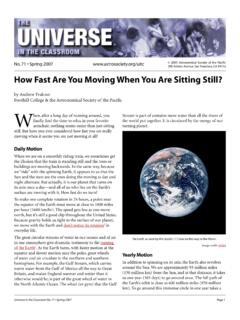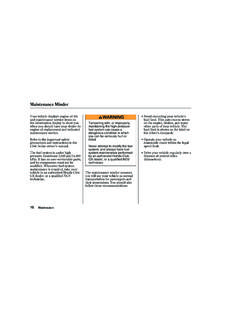Transcription of 0 per cent of the world’s - United Nations
1 Factsheet: People and Oceans General The ocean is vast, covering 140 million square miles (363 million square km), equivalent to approximately 72 per cent of the earth's surface. More than 600 million people (around 10 per cent of the world's population) live in coastal areas that are less than 10 meters above sea level. Nearly billion people (about 40 per cent of the world's population) live within 100 km (60 miles). of the coast. Oceans, coastal and marine resources are very important for people living in coastal communities, who represent 37 per cent of the global population in 2017.
2 Health and nutrition Human health is being impacted by the enhanced survival and spread of tropical diseases due to increasing ocean temperatures. Fish is one of the most important sources of animal protein. It accounts for about 17 per cent of protein at the global level and exceeds 50 per cent in many least-developed countries. The nutrients found in fish are important for optimal neurodevelopment in children and for improving cardiovascular health. Sustainable livelihoods and decent work About 97 per cent of the world's fishermen live in developing countries and fishing is their major source for food and income.
3 Women account for most of the workers in secondary marine-related activities such as fish processing and marketing. Overall, 80 per cent of the world's fish stocks for which assessment information is available are reported as fully exploited or overexploited. Illegal, unregulated, unreported fishing affects about 20. per cent of the global fish yields, which cost about $US23 billion a year. An estimated 27 percent of landed fish is lost or wasted between landing and consumption. Small scale fisheries supply almost half of the world's seafood stock. Small scale fisheries are however, among others, disadvantaged by lack of access to markets, even domestically, and a lack of pricing power.
4 Economy The ocean-economy, which includes employment, ecosystem services provided by the ocean, and cultural services, is estimated at between US$3-6 trillion/year. Fisheries and aquaculture contribute $US100 billion per year and about 260 million jobs to the global economy. Shipping is responsible for more than 90 per cent of the trade between countries. The global oceans- based economy is estimated at $US3 trillion a year, which is around 5 per cent of global GDP. Approximately 50 per cent of all international tourists travel to coastal areas. In some developing countries, notably Small Island Development States, tourism accounts for over 25 per cent of GDP.
5 Factsheet: Marine pollution Marine debris More than 8 million tonnes of plastic enter the oceans each year, equal to dumping a garbage truck of plastic every minute. As much as 80 per cent of all litter in our oceans is made of plastic. As many as 51 trillion microplastic particles 500 times more than the stars in our galaxy litter our oceans and seas, seriously threatening marine wildlife. Marine debris is harming more than 800 species. 40 per cent of marine mammals and 44 per cent of seabird species are affected by marine debris ingestion. According to some estimates, at the rate we are dumping items such as plastic bottles, bags and cups after a single use, by 2050 oceans will carry more plastic mass than fish, and an estimated 99 per cent of seabirds will have ingested plastic.
6 Plastic waste kills up to 1 million sea birds, 100,000 sea mammals, marine turtles and countless fish each year. Plastic remains in our ecosystem for years, harming thousands of sea creatures every day. Abandoned, lost or otherwise discarded fishing gear in the oceans makes up around 10 percent (640. 000 tonnes) of all marine litter. This gear continues to catch fish through so called ghost fishing , and also traps turtles, seabirds and marine mammals. Land-based activities 80 per cent of all pollution in seas and oceans comes from land-based activities. Nitrogen loads to oceans roughly tripled from pre-industrial times due to fertilizer, manure and wastewater.
7 The global economic damage of nitrogen pollution is estimated at $200 800 billion per year. In many parts of the world, (urban) sewage flows untreated, or under-treated, into the ocean. Pollution and eutrophication (excessive nutrients in water) are also caused by run off from the land, which cause dense plant growth and the death of animal life. The five large marine ecosystems most at risk from coastal eutrophication are: Bay of Bengal, East China Sea, Gulf of Mexico, North Brazil Shelf and South China Sea. Increased nutrient loading from human activities, combined with the impacts of climate change and other environmental change has resulted in an increase in the frequency, magnitude, and duration of harmful algal blooms worldwide.
8 These algal blooms can contaminate seafood with toxins, and impact ecosystem structure and function, recreational activities, fisheries, tourism and coastal property values. Nutrient over-enrichment from agricultural, municipal and industrial sources contributes to the so- called dead zones hypoxic regions that exhibit oxygen levels that are too low to support many aquatic organisms including commercially desirable species. The extent and duration of dead zones . is also increasing worldwide. Oil spills Oil tankers transport some 2,900 million tonnes of crude oil and oil products every year around the world by sea.
9 In addition to large tanker incidents, small oil spills happens every day, due to drilling incidents or leaking motors, and cause the death of birds, marine mammals, algae, fish and shellfish. Oil spills remain a concern, though actual spills have decreased steadily for several decades. Factsheet: Biodiversity Biosphere The world's oceans contain somewhere between 500,000 and 10 million marine species. Marine phytoplankton (the plant components of the plankton community) produces 50 per cent of oxygen on Earth. Oceans have absorbed as much as half of all anthropogenic carbon emissions over the past two centuries.
10 Blue carbon ecosystems such as mangroves, seagrass beds, tidal marshes and other marine and coastal vegetated ecosystems are among the most intense carbon sinks on the planet. The species diversity in the oceans ranges from to million species, with millions more bacteria, other microbes and viruses. Much of the biodiversity in the ocean, particularly in the deep sea and in the microbial ocean, is unknown, and up to 2,000 new species are described per year. Loss of Biodiversity Coral reefs (both tropical and cold water) are very sensitive to ocean acidification, with 60 per cent of reefs currently threatened by a combination of ocean warming, acidification and other anthropogenic impacts, a number that will rise to 90 per cent by 2030 and about 100 per cent by 2050.



















